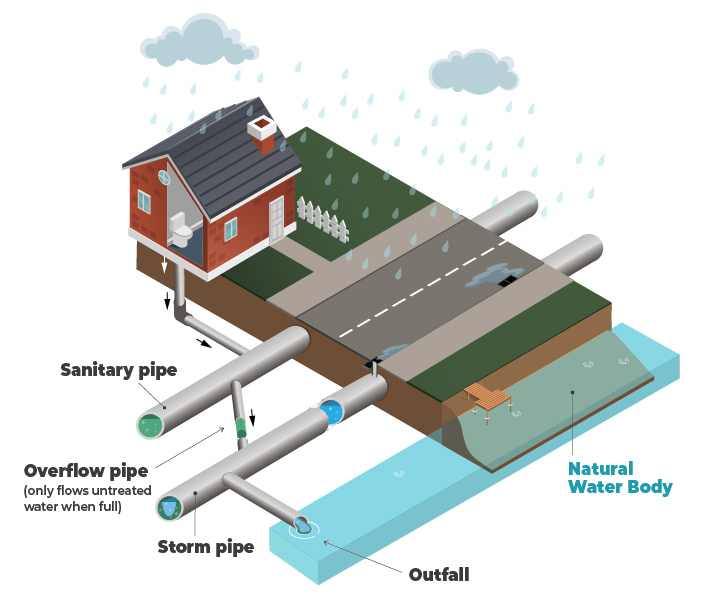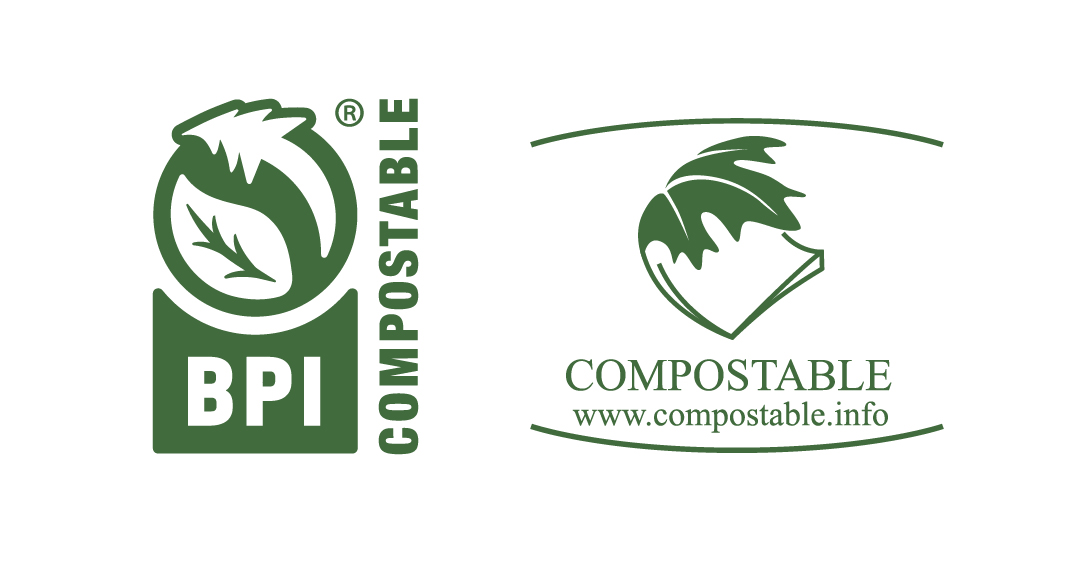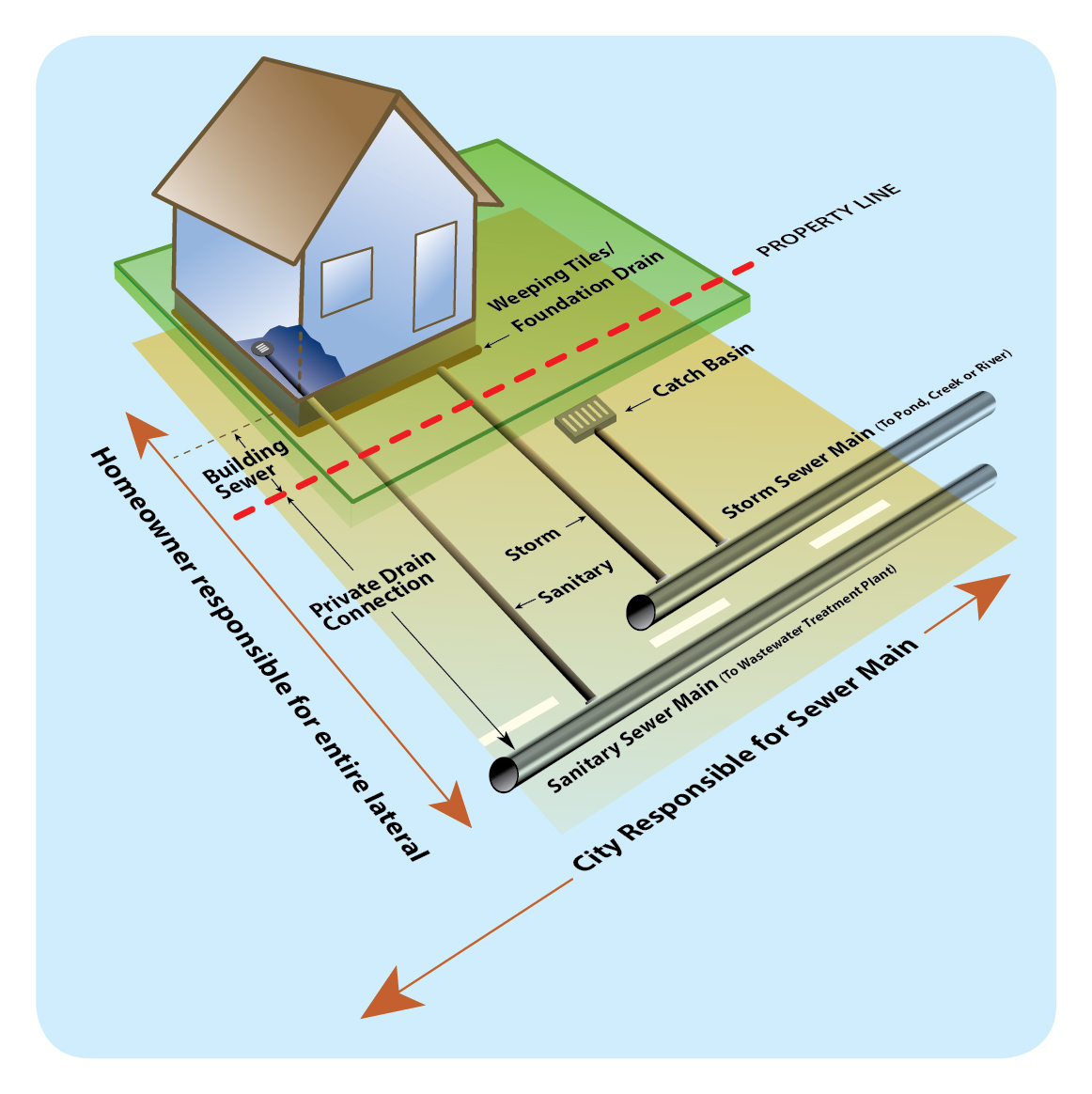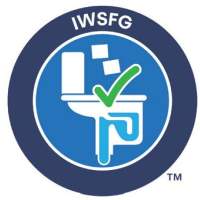The City of London currently manages five wastewater treatment plants and 38 pumping stations. Keeping London's pipes free and clear helps reduce back ups, basement flooding, and environmental impacts.
As part of the City’s Environmental Compliance Approval, signs are posted at publicly accessible sites close to overflow locations. These signs are meant to inform the public that overflows may occasionally discharge untreated or partially treated sewage into nearby water bodies, particularly during heavy rain events.
Overflow outfall signs
If I see water flowing out of an outfall, is it dangerous?
It’s normal to see water coming out of an outfall. This is usually just stormwater, especially after it rains. In some cases, during very heavy rain, the sewer system can get overwhelmed and a small amount of untreated wastewater may mix with stormwater. When this happens, it is heavily diluted. These events only occur when there’s more water than the system can handle.
What is a combined sewer overflow (CSOs) and a sanitary sewer overflow (SSOs)?
- A CSOs referred to as combined sewer overflow which is when a single sewer system carrying both wastewater (sewage) and stormwater overflows due to heavy rainfall, discharging untreated water into waterways.
- A SSOs referred to as sanitary sewer overflow which is when untreated wastewater or stormwater or partially treated water is released from the sanitary sewer system into the environment. This can happen due to a variety of reasons, including blockages or heavy rainfall overwhelming the system.
Why are the signs going up?
As part of the City’s Environmental Compliance Approval, signs must be installed at locations downstream of combined sewer overflow (CSO) and sanitary sewer overflow (SSO) outfalls. These signs are meant to inform the public that overflows may occasionally discharge untreated or partially treated sewage into nearby water bodies, particularly during heavy rain events.
Where will the signs be installed?
- Signs will be placed at the nearest publicly accessible downstream point from identified CSO and SSO outfalls.
- Locations vary from highly visible riverbank paths to less-traveled maintenance areas, depending on site access and proximity to the overflow.
If you have any questions about overflow outfall signs, please reach out to sewers@london.ca.

Above: Infographic of a Sanitary Sewer Overflow (SSO). It occurs when heavy rainfall overwhelms the system. Storm pipes fill with water from catch basins, while sanitary pipes are overloaded by foundation drainage from weeping tiles. Once sanitary pipes reach capacity, excess flow can enter the storm system. If the storm system is also overwhelmed, partially untreated wastewater may be released into a natural waterbody.
Overflows and bypasses
What are overflows?
Overflows are pipes that help protect homes and the sewer system during heavy rainfall. They are pipes connected from the sanitary sewer (which carries wastewater from toilets, sinks, and showers) to the storm sewer (which carries rainwater from streets and rooftops).
When there’s too much water in the sanitary sewer – usually because of a big rainstorm or melting snow – the overflow pipe gives the extra water a place to go. Instead of backing up into homes, the extra flow is sent into the storm sewer system.
Without these overflow connections, water could build up in the pipes and cause flooding in basements. Overflows help lower that risk by giving the system some relief during extreme weather.
What is a bypass?
A wastewater treatment plant bypass occurs when the flow exceeds capacity of a treatment process within the treatment plant. During a bypass, partially treated wastewater and storm water may be discharged. The wastewater treatment plant fully treats as much sewage as possible prior to any bypass, and then provides partial treatment to everything else.
Overflows and bypasses are a last resort measure to prevent basement flooding and damage to treatment processes during severe weather.
Current overflow and bypass information
Near real-time information about overflows and bypasses from the City’s wastewater facilities is now available online.
The City is collecting feedback about this new interactive map of overflow and bypass information. To share feedback, please visit getinvolved.london.ca/overflows-and-bypasses
How can you help?
Reducing the number of weeping tile connections to the sanitary sewer helps prevent overflow and bypass issues. It is estimated that there are approximately 50,000 homes within the City of London that have weeping tiles directly connected to the sanitary sewer. During heavy rainfall, these connections can overwhelm the sewer system, leading to basement flooding, sewer overflows, and bypasses.
If your home was built before the 1990s, your weeping tiles may be connected to the sanitary sewer. You can have your weeping tiles disconnected from the sanitary sewer and redirected to a sump pump, which can discharge to the surface or connect to the City’s stormwater system.
The City has a Basement Flooding Grant Program to help homeowners with the cost of these improvements. This program provides financial assistance for backwater valve installation, weeping tile disconnection and other flood prevention measures, helping protect your property and improve the efficiency of the City's sewer systems.
For further questions about the Basement Flooding Grant By-law, or to find out if you qualify for grant program, please contact sewers@london.ca or call 516-661-2489 x5489
Bypasses and overflows at wastewater treatment plants (WWTP) and pumping stations for 2024. Volumes are in cubic metres and durations are in hours.
| Site | Date | Duration Hours | Raw overflow | Raw bypass | Primary treated bypass / overflow | Primary bypass / overflow (secondary treated) |
| Pottersburg WWTP | March 5, 2025 | 24.58 | 14,955 | 0 | 0 | 0 |
| Greenway WWTP | March 5, 2025 | 85.43 | 0 | 0 | 135,051 | 0 |
| Adeliade PS | March 5, 2025 | 1.96 | 268 | 0 | 0 | 0 |
| Adelaide WWTP | March 5, 2025 | 36.53 | 0 | 0 | 19,380 | 0 |
| Dingman PS | March 6, 2025 | 3.66 | 0 | 0 | 1,350 | 0 |
| Greenway WWTP | March 9, 2025 | 9.82 | 0 | 0 | 6,215 | 0 |
| Greenway WWTP | March 15, 2025 | 73.97 | 0 | 0 | 51,738 | 0 |
| Adelaide PS | April 2, 2025 | 33.67 | 4,647 | 0 | 0 | 0 |
| Adelaide WWTP | April 2, 2025 | 40.90 | 0 | 0 | 36,522 | 0 |
| Greenway WWTP | April 2, 2025 | 36.92 | 0 | 0 | 45,464 | 0 |
| Oxford WWTP | April 2, 2025 | 23.60 | 0 | 0 | 2,666 | 0 |
| Pottersburg WWTP | April 2, 2025 | 33.07 | 36,540 | 0 | 0 | 0 |
| Vauxhall WWTP | April 2, 2025 | 10.00 | 0 | 0 | 0 | 1,069 |
| Berkshire PS | April 2, 2025 | 11.63 | 732 | 0 | 0 | 0 |
| Medway PS | April 2, 2025 | 12.00 | 4,761 | 0 | 0 | 0 |
| Greenway WWTP | April 3, 2025 | 87.92 | 0 | 0 | 100,987 | 24,621 |
| Vauxhall WWTP | April 3, 2025 | 2.25 | 0 | 0 | 121 | 0 |
| Dingham PS | April 3, 2025 | 57.50 | 0 | 0 | 65,189 | 0 |
| Greenway WWTP | April 29, 2025 | 0.93 | 0 | Power Failure | 0 | Power Failure |
| Pottersburg WWTP | May 5, 2025 | 1.15 | 262 | 0 | 0 | 0 |
| Vauxhall WWTP | May 5, 2025 | 0.88 | 0 | 0 | 0 | 1,346 |
| Vauxhall WWTP | May 16, 2025 | 0.15 | 0 | 0 | 0 | 15 |
| Vauxhall WWTP | June 5, 2025 | 0.09 | 0 | 0 | 0 | 321 |
| Adelaide WWTP | June 15, 2025 | 1.50 | 0 | 0 | 0 | 2,020 |
| Pottersburg WWTP | June 22, 2025 | 0.12 | 116 | 0 | 0 | 0 |
| Pottersburg WWTP | June 24, 2025 | 0.68 | 6,109 | 0 | 0 | 0 |
| Vauxhall WWTP | June 24, 2025 | 0.02 | 0 | 0 | 0 | 2.3 |
| Vauxhall WWTP | June 25, 2025 | 0.25 | 0 | 0 | 0 | 259 |
Fats, Oils and Grease (FOG) Cups and Fatbergs
Free FOG Cups can be picked up at City of London EnviroDepots and at London Public Library locations.
- Put into a food soiled paper product (i.e. paper egg carton, soiled food paper packaging not coated in plastic such as a flour bag) or use newspaper to soak up
- Pour small amounts directly into your Green Bin. Use a paper or certified compostable liner in your Green bin to contain and/or absorb the material.
What is FOG and why do we collect it?
Fats, oils, and grease (FOG) can block London's sewer system when they're poured down your sink or into your toilet. When FOG hardens, you could end up flooding your basement or even your neighbour's.
What is a fatberg and how can you prevent them?
FOG cups
The City of London provides residents with FOG cups for no charge (limit 2 per household per visit) to collect their fats, oils and grease. When the cup is full, it may be returned to a City of London EnviroDepot where it will be used to generate green energy.
One full FOG Cup can be turned into enough energy to power a refrigerator for a day.
The certified compostable FOG cups can also be placed inside the Green Bin, including the lid. If you are not using a FOG cup, you can also collect fats, oils and grease in a coffee cup or can that you can place into the freezer. If using a coffee cup or can please put into the garbage.
Certified compostable cups may also be used for FOG and put into the Green Bin. Please look for one of these logos on the cup or packaging:

FOG can go directly into the Green Bin. Before washing pots, pans and dishes wait for the FOG to solidify by letting it cool at room temperature or in the fridge. Scrape it into the Green Bin and use an absorbent material such as paper towel or soiled paper to wipe out the container and put into the Green Bin.
Small amounts of liquid cooking oils that will not solidify can be poured directly into the Green Bin. It may help to use a certified compostable liner or paper liner along with absorbent soiled paper products to soak it up. Large amounts of liquid cooking oil should be put into a tightly sealed container and dropped off at the EnviroDepots.
If you have questions related to FOG cups, please contact Waste Management at Jcorby@london.ca or call 519-661-2489 x 5419.
Private Drain Connection
A Private Drain Connection is the portion of sewer pipe from your property line to the City’s sanitary sewer main. The portion of the pipe on private property is called the building sewer. Together, the Private Drain Connection and the building sewer are known as the sanitary lateral pipe.
The homeowner is financially responsible for the entire length of the sanitary lateral pipe. The main distinction between the two sections of pipe is that City staff may be involved in the repair work for the Private Drain Connection portion, while the maintenance, repair and replacement of the building sewer can be done by any qualified contractor the homeowner chooses in accordance with appropriate permits.
The homeowner is responsible for the entirety of the pipe because the homeowner controls what is discharged to this sewer pipe from their property.
The City is responsible for the sanitary sewer main within the roadway that runs in front of the property.
Please refer to the City of London’s Drainage By-law for more information.

What do I do if a Private Drain Connection is blocked?
Blockages can be a health hazard when wastewater backs ups into your basement and damages your property.
If you are currently flooding or recently experienced flooding in your basement, contact the City at 519-661-4570 (Monday to Friday 8:30 a.m. to 4:30 p.m.) or 519-661-4965 (after hours). The City will send staff out to the property to determine if the City sewer main under the road is functioning properly, at no cost to the homeowner. If it is determined that the City's sewer main is the issue, the City will repair the sewer main.
Blockages that occur between the building and the City’s main sewer pipe are the sole responsibility of the homeowner and resident.
There are several reasons why the sanitary lateral pipe may be blocked. There may be a pipe collapse or obstruction in the pipe caused by tree roots, a buildup of grease, flushable wipes, or other objects.
If the issue is your sanitary lateral pipe, you should contact a licensed plumber/drainage contractor to determine whether the problem is in the building sewer or the Private Drain Connection.
If the blockage is within the building sewer (private property):
Call a qualified contractor of your choice (multiple quotes are suggested).
You may need to obtain a plumbing permit. Call (519) 661-4555, email epermits@london.ca or building@london.ca
If the blockage is within the Private Drain Connection (City property):
- Call a qualified contractor of your choice (multiple quotes are suggested).
- Obtain a Permit of Approved Works (PAW) by calling (519) 661-CITY (2489) Ext 2848 or email streetpermit@london.ca.
OR
- If your property is a residential, single-family home, duplex, triplex, 4-plex, 5-plex, or 6-plex, you may request to have the Private Drain Connection replaced by the City of London. The City currently offers this Private Drain Connection renewal service for a flat-rate fee of $6,500, which can be paid as a lump sum, or on your property taxes over a 10-year period. Please call (519) 661-4570 or email service@london.ca for more information.
What will the City do?
As soon as payment is received, City Sewer Operations will:
- Inspect the Private Drain Connection with a sewer camera
- Clean the Private Drain Connection, if necessary
- Determine the method of repair or replacement
- Either open-cut replace, pipe-burst replace, or line the PDC
- Restore to preconstruction condition
Private Drain Connection replacement during a City construction project
If the City is undertaking a reconstruction project where the mainline sewer is being replaced, all existing Private Drain Connections connected to this sewer will also be replaced between the mainline sewer and a point approximately 2 metres behind curb (this may vary from project to project depending on other external factors such as trees). The length of the remaining existing Private Drain Connection will vary depending on a number of factors including the street Right-Of-Way, location of mainline sewer, and width of roadway.
Can obstructions be caused by other utilities?
If it is determined that there is an obstruction within the sanitary lateral pipe, contact Ontario One Call at 1-877-969-0999. On rare occasions, another utility such as hydro, phone, or natural gas, may have inadvertently installed their infrastructure through the sanitary lateral pipe. By calling Ontario One Call, a free inspection will be scheduled to determine if another utility is interfering with your pipe.
Do I need to replace my Private Drain Connection?
If your Private Drain Connection is blocked due to a grease buildup, it may not be necessary to replace it. Once the cause of the blockage is removed, the Private Drain Connection should be functioning properly with no further action needed.
If the Private Drain Connection is starting to deteriorate, it may be in good enough condition to simply be lined with a new layer to maintain its integrity. Lining a Private Drain Connection eliminates the need to dig up the original pipe, resulting in less of a disturbance to your property.
If the Private Drain Connection has collapsed or is severely damaged, there may be no other solution than to replace it.
Can the City help with the cost of preventing flooding?
The City has a Basement Flooding Grant Program that was designed to provide financial assistance to homeowners who want to disconnect their weeping tiles from the City’s sewer systems and install a sump pit and sump pump, and a backwater valve.
What is a cleanout and where do I find It?
A cleanout is a direct access point to the building sewer and/or the Private Drain Connection. If there is a blockage along your pipe from the house to the road, the cleanout is a point of entry to try and free the blockage without digging up your front lawn. Cleanouts in homes constructed within the last 45 years are usually located near the front of the house, under the basement floor, where the pipe exits the house. The cleanout can also be located outside the home and may be buried. If a cleanout exists, information may be available on its location and size.
Combined sewers
In some cases, both sanitary and stormwater drain into a common pipeline that leads it to a nearby wastewater treatment plant. This type of sewer is no longer constructed, but is occasionally found in old sewer systems.
The City of London has invested almost $11 million into separating combined sewers in the downtown over the last three years. These measures help mitigate the sewer system by reducing, or even eliminating, the chance of wastewater overflows.
Best practices for residents and businesses
Toilets and sinks are not garbage cans
Drains are designed for wastewater and toilet paper only. Flushing the wrong things down your toilet or sink can block sewer pipes and may cause flooding at your home. It is also extremely important to keep medicines and garbage out of the toilet.
The IWSFG seal of approval

"Flushable" and "Biodegradable" are both unregulated terms, meaning they can be put on just about anything. The best way to know if a wipe can or cannot be flushed is to check packaging for the seal of approval from the International Water Services Flushability Group (IWSFG).
Wipes without the IWSFG seal of approval always belong in the garbage bin, even if the wipe package says "flushable".
What can I flush?
Flushable:
- Toilet paper
- Urine & feces
- Wipes with the IWSFG seal of approval
DO NOT flush:
- Wipes (baby, disinfectant, etc.) that don't have the IWSFG seal of approval
- Paper towels
- Menstrual products (tampons, pads, etc.)
- Cotton balls and pads
- Condoms
- Plastics of any kind (no matter how small!)
- Medicine (Remember to always dispose of medicines by taking them to your pharmacy)
- Face masks
Only rain should go down the drain
Storm sewers and catchbasins collect water outside and drain directly into the nearest creek, river or lake. This water is not treated, so it is important to not put waste such as animal waste, automotive fluids, garbage, and chemicals down a catchbasin.
Pouring any chemicals in the storm sewer is illegal and pollutes our rivers and lakes.
One litre of motor oil spilled down a catchbasin can contaminate one million litres of water.
When you wash your car on your driveway or the street, the soapy, dirty water runs into our creeks and river. To avoid having dirty water run into our storm sewer system, consider these options for washing your car:
- Use a commercial car wash facility. These facilities treat wastewater and discharge it into the sanitary sewer system where it will receive further treatment. Commercial car washes are regulated to practice water conservation. Washing your car at home can use as much as 50 percent more water.
- Find a location where the wastewater won’t flow into the storm sewer. For example, washing cars on a gravel surface or grass allows the wastewater to be absorbed before it reaches the storm sewer.
Draining pools and hot tubs
If you are draining a pool or hot tub, remember to dechlorinate the water and drain onto your lawn, if it can be properly absorbed into the ground without flowing onto your neighbours property or storm water system.
Salt water pools should be discharged to the sanitary system connection on your property. The water from salt water pools have such high levels of chlorides that this water cannot be discharged to the storm sewer system.
Restaurant grease
Grease build up is often the main cause of sewer back ups at restaurants. Grease interceptors are required anywhere food is cooked, processed or prepared.
Grease interceptors are containment units designed to trap grease, oil, solids and other debris. They prevent these substances from getting into the sanitary sewer system where they can eventually block the entire pipe. Grease interceptors need to be properly sized, installed and maintained. Cleaning food wastes and oil out of grease interceptors is required on a regular basis.
Oil and grit separators
Oil and grit separators are structures integrated into the City’s stormwater system. As rain and melted snow wash from the ground surface and enter stormwater grates located on roads and in parking lots, oil and grit separators:
- Remove sediment
- Screen debris
- Separate oil
Property and business owners are responsible for maintaining this device as per London’s Waste Discharge By-law. Spills happen, so make sure your oil and grit separator is working properly to capture them.
If an oil and grit separator is not maintained, it can result in toxic runoff entering our stormwater system
Construction sites
Erosion and sediment control plans are an integral part of site development and construction sites. Sanitary sewers are not built to handle storm water from construction sites and basements.
It is also important to manage wash water at a construction site. Wash water for latex paint or concrete should never go into the storm sewer system.
For more information and educational materials, please contact Wastewater Treatment Operations at 519-661-5701
